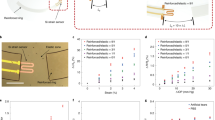Abstract
A new kind of contact lens electrode is described which has superior electrical characteristics to the traditional type and overcomes many of its disadvantages. In addition it can permit unimpaired vision by the subject for the simultaneous recording of ERG and pattern VER
Of all electrophysiological signals the electroretinogram (ERG) provides the investigator with a site which is at once the best and the worst for recording. No other signal can be recorded from the surface with such a direct electrical pathway to its source; no other surface electrode site is as sensitive as the cornea. Hence, although the ERG can be recorded using skin electrodes, some means of making electrical contact with the cornea is invariably used. Fundamentally, the method of making this contact has not changed since it was described by De war (1877). Isotonic saline solution is held in contact with the cornea by means of a container of some kind and this also supports an electrode (generally metallic) with its end in the saline. The design of the saline container has been greatly improved since Dewar used a ring of clay and Hartline (1925) used goggles. The major step forward was the introduction of the contact glass electrode independently by Riggs (1941) and Karpe (1945). Electrodes of this type, including the many variations subsequently introduced by other workers, are commonly in use today. The contact glass is made of moulded plastic and the most favoured material for the electrode is silver, although stainless steel and, occasionally, gold or platinum are used. The main disadvantages of the contact glass electrode are discomfort, difficulty in avoiding air bubbles, which spoil the electrical contact, and difficulty in fitting. On the other hand they can be fenestrated if clear vision is required (Jacobson et al. 1958) and the photovoltaic artefact may generally be avoided by the use of sufficient black paint (Best, 1953).
Access this chapter
Tax calculation will be finalised at checkout
Purchases are for personal use only
Preview
Unable to display preview. Download preview PDF.
Similar content being viewed by others
References
Best, W. Das menschliche Elektroretinogram während der Dunkeladaption. Acta Ophthal., 31, 71–116, (1953).
Bornschein, H., Wichterle, O. & Wündsch, L. A contact lens electrode for comparative ERG studies. Vision Res., 6, 733–734, (1966).
Dawson, W. W., Zimmerman, T. J. & Houde, W. L. A method for more comfortable electrorctinography. Arch. Ophthal., 91, 1–2, (1974).
Dewar, J. The physiological action of light. Nature, 15, 433–435, (1877).
Hartline, H. K. The electrical response to illumination of the eye in intact animals, including the human subject; and in decerebrate preparations. A. J. Physiol., 73, 600–611, (1925).
Jacobson, J. A new contact lens electrode for clinical electroretinography. Arch. Ophthal., 54, 940–941, (1955).
Jacobson, J., Romaine, H. H., Halberg, O. P. & Stephens, G. The electrical activity of the eye during accomodation. Am. J. Ophthal., 46, 231–238, (1958).
Karpe, G. The basis of clinical electroretinography. Acta Opthal. Supplementum, 24, 1–118, (1945).
Riggs, L. A. Continuous and reproducible records of the electrical activity of the human retina. Proc. Soc. exp. Biol. Med., 48, 204–207, (1941).
Schoessler, J. P. & Jones, R. A new corneal electrode for electroretinography. Vision Res., 15, 299–301, (1915).
Wündsch, L. & Lützow, A. V. Zur Ausschaltung des becquereleffektes in der elektroretinographie. Experientia, 25, 1119–1120, (1969).
Author information
Authors and Affiliations
Editor information
Rights and permissions
Copyright information
© 1977 Dr W. Junk b.v. Publishers
About this chapter
Cite this chapter
Barber, C., Cotterill, D.J., Larke, J.R. (1977). A New Contact Lens Electrode. In: Lawwill, T. (eds) ERG, VER and Psychophysics. Documenta Ophthalmologica, vol 13. Springer, Dordrecht. https://doi.org/10.1007/978-94-010-1312-3_48
Download citation
DOI: https://doi.org/10.1007/978-94-010-1312-3_48
Publisher Name: Springer, Dordrecht
Print ISBN: 978-94-010-1314-7
Online ISBN: 978-94-010-1312-3
eBook Packages: Springer Book Archive




